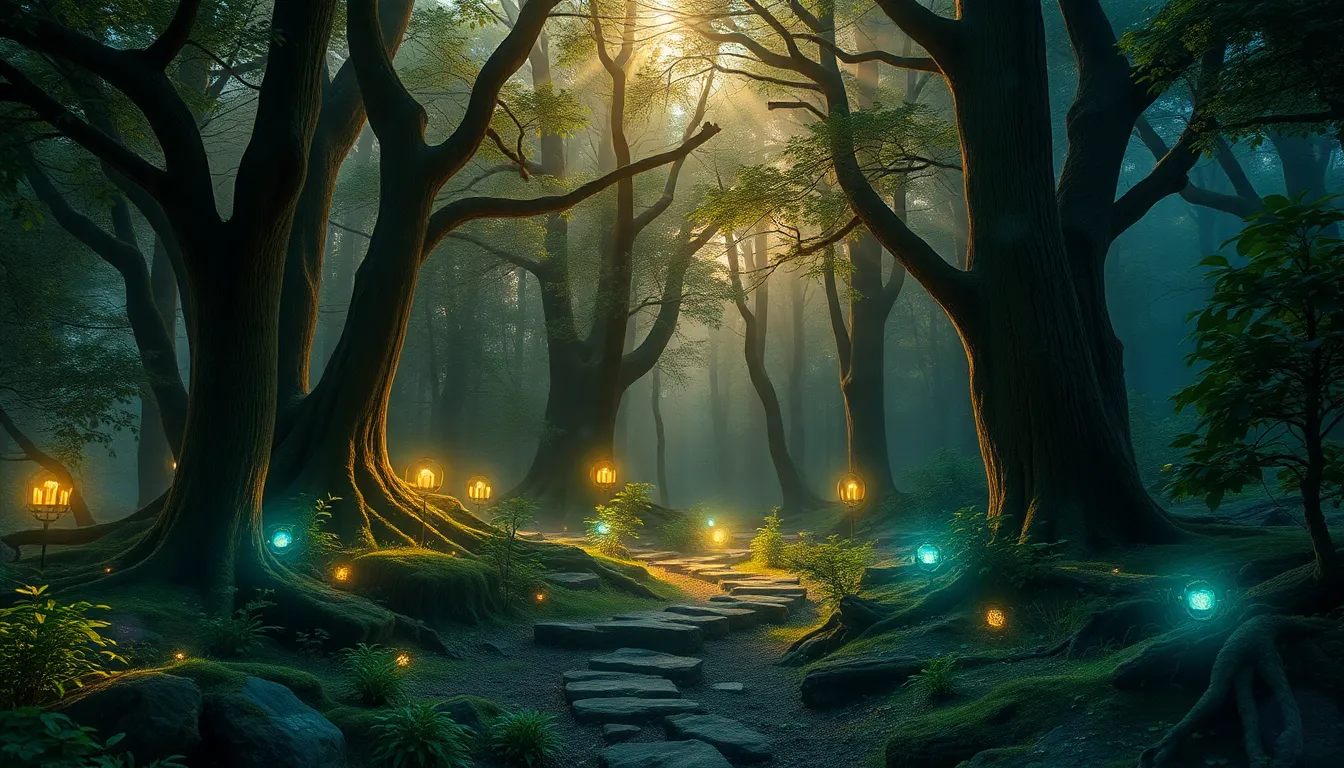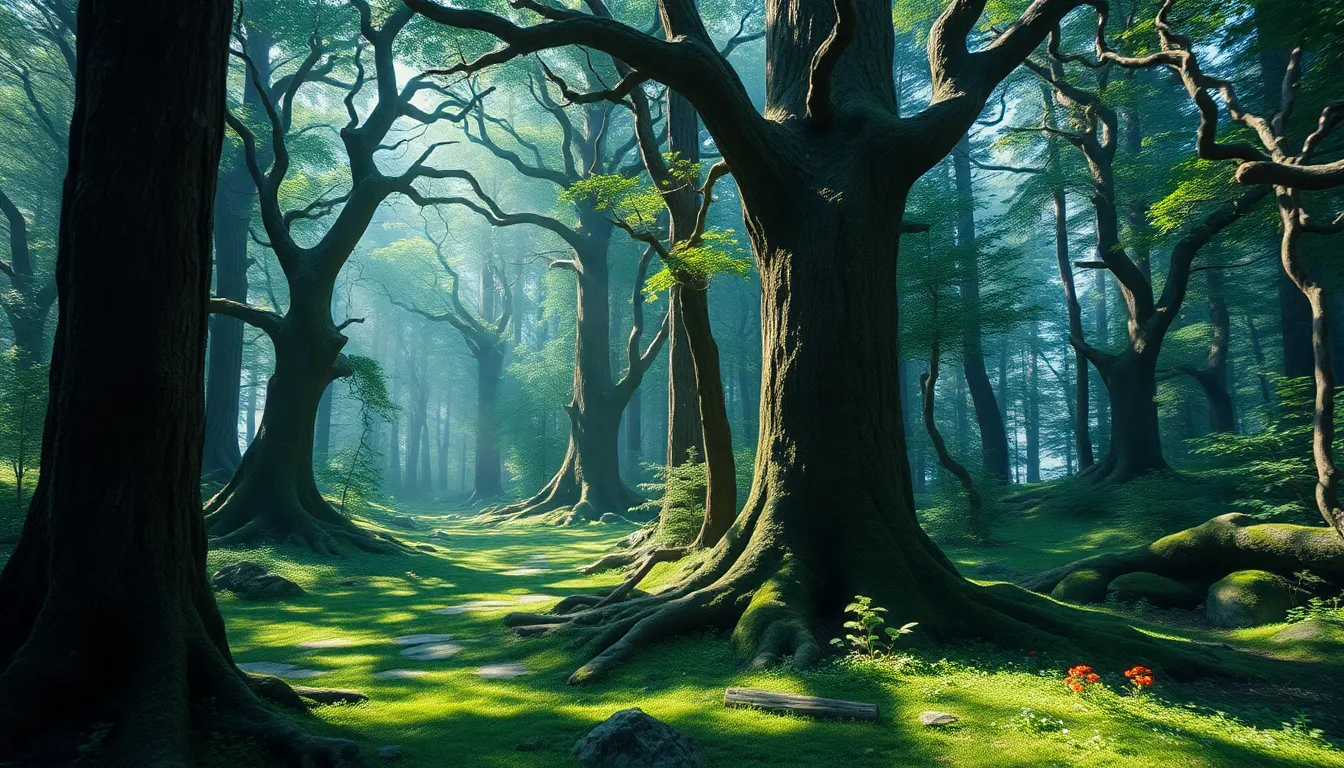The Enchanted Forest: A Journey into Mythical Realms
I. Introduction to the Enchanted Forest
The concept of the enchanted forest has fascinated humanity for centuries, representing a space where the ordinary intersects with the extraordinary. Enchanted forests are often depicted as lush, vibrant environments filled with magical creatures and hidden wonders. They serve as gateways to mythical realms that challenge our understanding of reality.
Culturally, enchanted forests hold significant meaning across various mythologies. They often symbolize transformation, adventure, and the unknown, inviting individuals to explore the depths of their imagination. Through this article, we aim to delve into the mythical realms within enchanted forests, uncovering their historical origins, unique features, and the profound impact they have on literature and popular culture.
II. Historical Origins of Enchanted Forests
The roots of enchanted forests can be traced back to early myths and legends. Many ancient cultures utilized forests as settings for their stories, often portraying them as places where the rules of nature were suspended, and the supernatural thrived. These narratives shaped the collective understanding of forests as enchanted spaces.
Ancient civilizations, such as the Celts and Greeks, contributed to the rich tapestry of forest mythology. In Celtic lore, for instance, the Otherworld was often depicted as a mystical forest realm inhabited by faeries and spirits. Similarly, Greek mythology features sacred groves dedicated to gods, blurring the line between the natural and the divine.
Folklore from diverse cultures around the world has also influenced our perception of enchanted forests. From the enchanted woods in Russian fairy tales to the deep, dark woods of Scandinavian myths, these stories reflect humanity’s fascination with the unknown and the magic that lies within the natural world.
III. Key Features of Enchanted Forests
Enchanted forests are characterized by unique flora and fauna that add to their mystical allure. The trees are often depicted as ancient and towering, their branches intertwined to create a canopy that filters light, casting enchanting shadows on the forest floor.
A. Unique flora and fauna associated with mythical realms
- Faerie Rings: Circular formations of mushrooms believed to be portals to the faerie realm.
- Whispering Trees: Trees said to communicate with those who listen closely.
- Magical Creatures: Beings like unicorns, griffins, and other mythical creatures inhabit these forests.
B. Magical elements: faeries, spirits, and mystical creatures
The enchanted forest is often populated by magical beings, including faeries, woodland spirits, and mythical animals. These entities are thought to possess unique powers and often serve as guides or guardians of the forest.
C. The interplay of light and shadow: creating a mystical atmosphere
The enchanting atmosphere of these forests is enhanced by the interplay of light and shadow. Dappled sunlight filtering through the leaves creates a dreamlike quality, inviting exploration and igniting the imagination.
IV. The Role of Enchanted Forests in Literature
Enchanted forests have played a pivotal role in literature, serving as backdrops for countless stories that explore themes of adventure, transformation, and self-discovery.
A. Overview of classic literary works featuring enchanted forests
Classic literature often features enchanted forests, such as:
- A Midsummer Night’s Dream by William Shakespeare – A tale of love and magic set in an enchanted wood.
- The Chronicles of Narnia by C.S. Lewis – The woods in Narnia are filled with magical creatures and adventures.
- Hansel and Gretel – A fairy tale that unfolds in a dark, enchanted forest.
B. Analysis of contemporary interpretations in fantasy literature
In contemporary fantasy literature, enchanted forests continue to captivate readers. Authors often use these settings to explore complex themes such as identity, belonging, and the struggle between good and evil. Works like The Hobbit by J.R.R. Tolkien and The Night Circus by Erin Morgenstern highlight the enduring allure of enchanted forests.
C. Symbolism of the forest as a place of transformation and discovery
Enchanted forests symbolize the journey of transformation. Characters often enter these woods facing personal challenges, and through their experiences, they emerge changed, reflecting the universal theme of growth and self-discovery.
V. Enchanted Forests in Popular Culture
The concept of enchanted forests has permeated modern popular culture, influencing films, television shows, and video games.
A. Depictions in films and television shows
Numerous films, such as Into the Woods and Pan’s Labyrinth, showcase enchanted forests as places of peril and wonder, where characters confront their fears and desires.
B. Video games that incorporate enchanted forest themes
Video games like The Legend of Zelda series and Ori and the Blind Forest immerse players in lush, vibrant environments filled with magical elements and challenges.
C. The impact of enchanted forests on modern storytelling
Enchanted forests continue to inspire storytellers, providing a rich backdrop for narratives that explore human emotions, relationships, and the quest for meaning.
VI. The Psychology of Enchantment: Why We Are Drawn to Forests
The allure of enchanted forests goes beyond their aesthetic appeal; they tap into deep psychological needs and desires.
A. The allure of nature and its psychological effects
Nature has a profound impact on mental well-being, with studies showing that time spent in natural environments can reduce stress and improve mood. Enchanted forests, with their magical qualities, enhance this connection, offering a sense of peace and wonder.
B. Enchanted forests as a metaphor for escapism and adventure
These forests represent a form of escapism, allowing individuals to step away from their daily lives and embark on adventures filled with magic and mystery. They serve as a canvas for our imagination.
C. Exploration of human connections to nature through mythical narratives
Mythical narratives surrounding enchanted forests often reflect humanity’s relationship with nature, highlighting themes of respect, reverence, and the understanding of our place within the natural world.
VII. Real-Life Enchanted Forests Around the World
Many real-life forests around the globe embody the spirit of enchantment, offering visitors a glimpse into the magical landscapes that inspire folklore and myth.
A. Description of notable enchanted forests in various countries
- Black Forest, Germany: A dense, dark forest known for its fairy tales and legends.
- Redwood National and State Parks, USA: Home to towering trees that evoke a sense of wonder.
- Forest of Dean, England: A forest rich in folklore and history, often associated with mythical creatures.
B. Cultural practices and rituals associated with these forests
Many cultures celebrate their enchanted forests through rituals, festivals, and storytelling traditions, preserving the magic and mystery of these natural spaces.
C. Conservation efforts to preserve both natural and mythical aspects
Efforts to conserve enchanted forests focus on protecting biodiversity while also honoring the myths and stories that connect communities to these magical places.
VIII. Creating Your Own Enchanted Experience
Exploring nature with a sense of enchantment can transform everyday outings into magical experiences.
A. Tips for exploring nature with a mindset of enchantment
- Embrace your curiosity: Look for small wonders in your surroundings.
- Practice mindfulness: Engage your senses to fully experience the environment.
- Use your imagination: Create stories or myths inspired by your surroundings.



